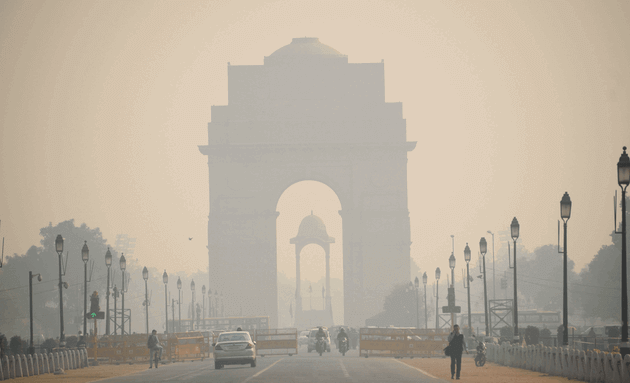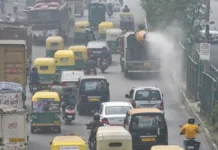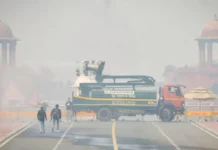NEW DELHI: With India grappling with soaring air pollution, especially in the Delhi NCR region, it is the children and the elderly who are the most vulnerable to toxic air. Citing the alarming situation with pollution levels far exceeding the unhealthy mark, school authorities are embracing comprehensive measures and tools to keep pollution in check in schools, where young children spend a significant portion of their day.
”Schools can integrate air quality monitoring systems by installing sensors across the campus that provide real-time data. This information can be shared with school administration and parents through digital platforms. At GD Goenka, Vasant Kunj when pollution levels exceed safe limits, we restrict outdoor activities, switch to indoor settings, and provide students with safe spaces with air purifiers,” says Dr Kevin Brady, Principal, GD Goenka Public School, Vasant Kunj.
Echoing his views, Rinku Pandey, PGT English, Seth Anandram Jaipuria School, Kanpur, states,”Monitoring air-quality forecasts will enable schools to understand the level of pollution in the air and accordingly restrict the outdoor activities of students when the pollution levels are high. Schools may encourage indoor activities to engage students on high-pollution days. If schools can afford it, they can install air purifiers in classrooms, so that children get to breathe better quality air.”
Speaking in a similar tone, Kanak Gupta, Group Director at Seth M.R. Jaipuria Schools underlines the significance of routine communication with guardians in such scenarios. ”First off, rescheduling outdoor activities to times when pollution levels are lower, typically early mornings, can substantially minimise exposure. In addition, utilising air quality monitoring tools like the Air Quality Index (AQI) can allow school authorities to stay informed and take prompt action when pollution levels are elevated. Moreover, schools should regularly communicate with parents about high-pollution days and advise precautions to ensure everyone is aware and prepared,” says Kanak Gupta.
Air pollution poses a significant threat to children’s health, affecting their respiratory systems and overall development. This makes it imperative for school management to take steps to safeguard them in school environments.
”At GD Goenka, we ensure that the school infirmary is stocked with the necessary equipment and medications for vulnerable students (with pre-existing respiratory conditions, such as asthma). The school has a state-of-the-art in-house ambulance along with a full-time doctor and nursing staff ready to respond to any medical emergencies,” says Dr Kevin Brady.
Similarly, Pandey underlines that in the wake of a pollution led health emergency indoor air filtration system must be a standard feature in schools.
”Indoor air filtration systems are the need of the hour, considering the amount of pollution which exists in the atmosphere around. I feel that indoor air filtration systems must become the standard feature in classrooms if we want our children to focus better during their classes and improve their overall health,” opines Pandey.
Agreeing with her views, Kanak Gupta further underscore the substantial benefits of installing air filtration systems in schools.
”Given their noteworthy benefits, indoor air filtration systems should certainly be a standard feature in classrooms. They offer a reliable way to ensure that students are breathing clean air, particularly during high-pollution days when outdoor air quality is hazardous,” says Kanak Gupta.
While restricting outdoor activities and deploying air purification systems are effective solutions for mitigating the harmful effects of pollution, school administrators believe that empowering students as change agents is vital for curbing pollution.
”The rising generation of students can play an important role in raising awareness of the long-term effects of air pollution, the value of urban green spaces, and the impact of harmful practices such as: burning garbage during the winter season, and bursting crackers. Students should see themselves as change agents and we, as their mentors, should encourage them to envision a future in which the air we breathe is increasingly pure and pollutant-free,” says Dr Brady.
Mentioning the importance of local environmental organisations in raising awareness about environmentally friendly practices, Pandey states, ”Schools can play a crucial role in generating environmental awareness. Working in close collaborations with local environmental organisations may give students opportunities for hands-on-experiences with sustainable practices. By attending expert talks and gaining practical experience, students get motivated to adopt these environmental-friendly practices in their regular course of action.”
In addition, experts are also of the firm opinion that green spaces in schools and eco-friendly practices can go a long way in reducing exposure to toxic air and pollutants.
”Adapting school infrastructure to counter the effects of pollution can include constructing green spaces with plants that absorb pollutants. Using trees and shrubs as barriers can also lower pollution from nearby roads and industrial zones. Embracing eco-friendly designs in school buildings, such as green roofs and walls, can also elevate air quality and reduce exposure to pollutants,” says Kanak Gupta.
Moreover, experts suggest that bringing indoor plants, such as Peace Lilies, Spider Plants, and Snake Plants, into classrooms can improve indoor air quality. Additionally, incorporating small water bodies or fountains on campus can help reduce dust and lower airborne particulate matter, while also creating a calming and aesthetically pleasing environment for students.
The combined efforts of school authorities, parents, and the community can foster healthier learning environments and contribute to a broader movement towards cleaner air and a sustainable future. As we continue to witness the challenges of air pollution, these proactive steps are essential in safeguarding the health and well-being of our children.
Also Read: GRAP-2 a call for pre-emptive action on Delhi-NCR air pollution







